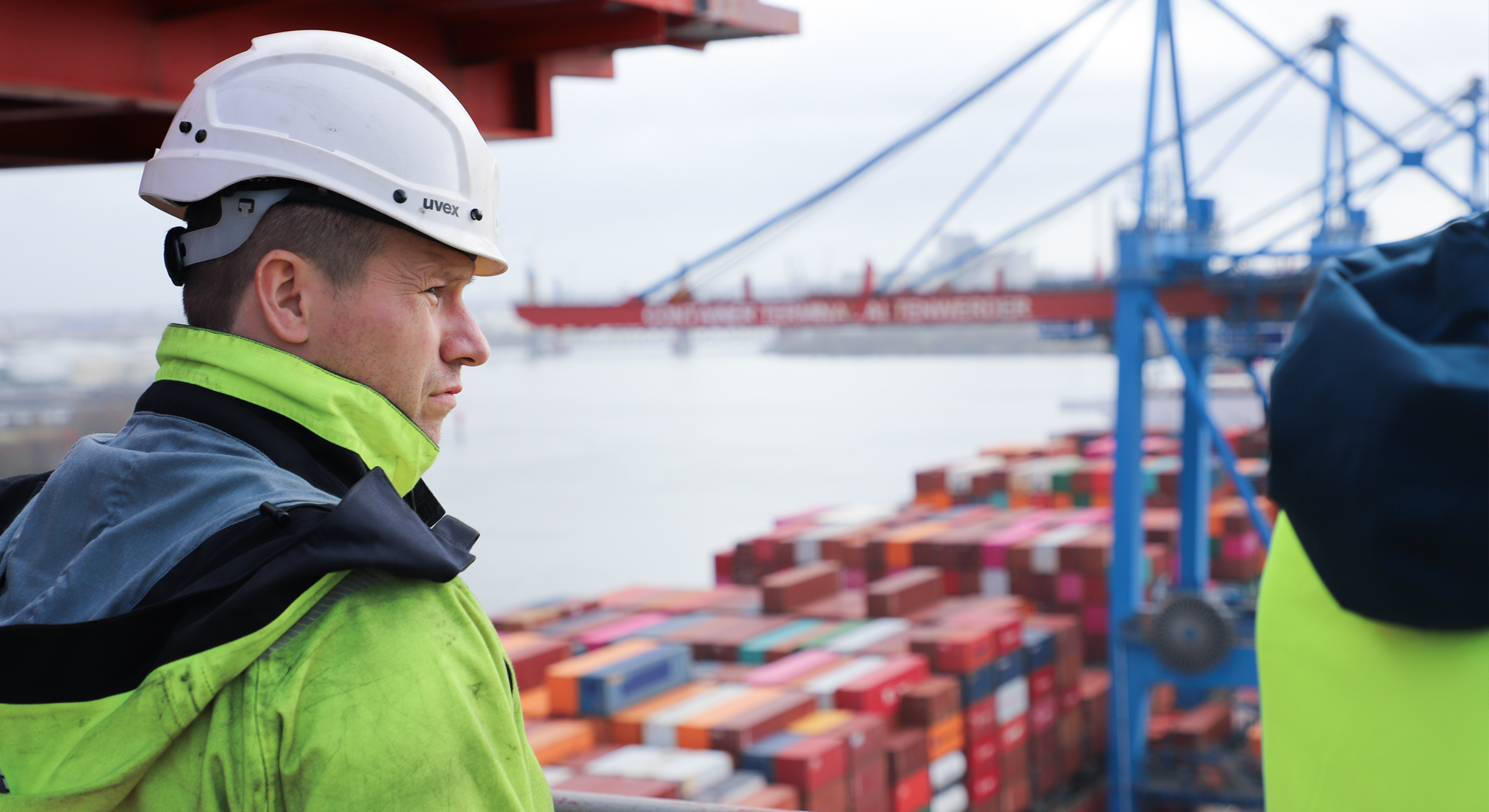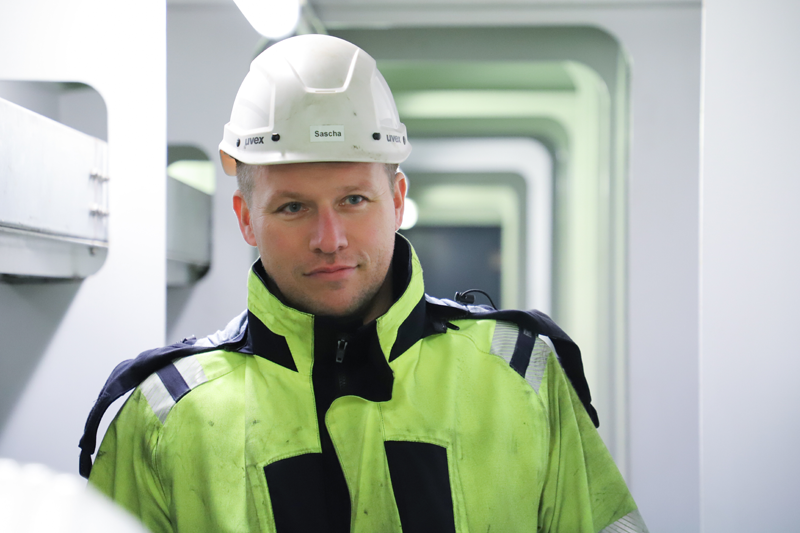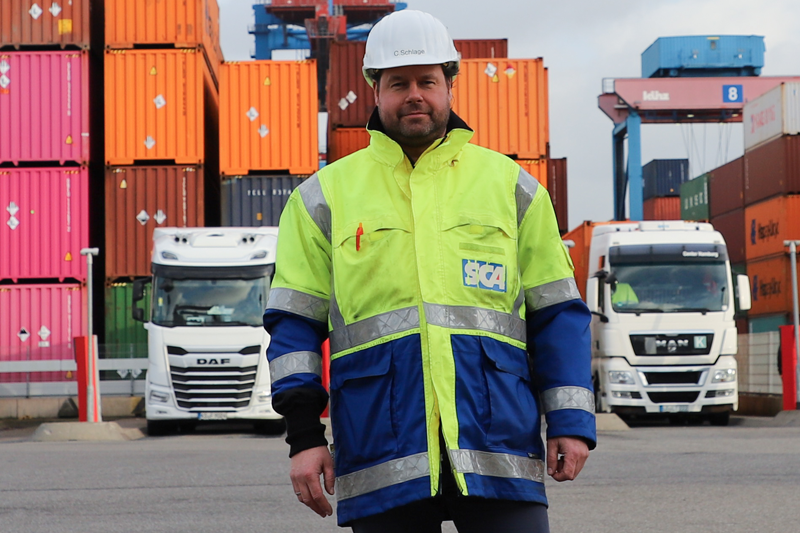From concept to reality
The industrial engineer Isabel Ziebart is involved in project management for the “Alte Süderelbe Western Bypass” of the Hamburg Port Railway. Her task is to ...

Almost 22 years ago, the HHLA Container Terminal Altenwerder (CTA) began operations and has since been the throughput facility with the greatest degree of automation at the Port of Hamburg. In order to maintain and repair the equipment, 150 employees work in shifts at the Altenwerder site at HHLA Technik. Highly specialised technicians are needed in the fault clearance service or maintenance team, in two workshops for 95 automated guided vehicles (AGVs) and around 100 “spreaders” (load handling equipment for containers), as well as in specialist teams for different equipment. Altogether, HHLA Technik has almost 500 employees across all its Hamburg sites – the CTA, Container Terminal Burchardkai (CTB) and Container Terminal Tollerort (CTT) – each of them working in concert.

The increasing development of automation requires more and more expertise. Regarding the AGV fleet, which was switched entirely to lithium-ion batteries by the end of 2023, Operations Manager Henning Verstege notes: “Mechanics with basic qualifications as electronics technicians or mechatronics engineers have all gone though high-voltage training, so they can work safely and effectively with the new technologies.”
Among them is Bernhard Martens, head mechanic at the AGV workshop. He has just parked an almost 27-tonne AGV as effortlessly as a toy, via remote control. He visibly enjoys his work – just like the interplay of technology at the port, which he finds “super interesting”. That is why he applied at the port in 2007, leaving a job at a car garage, and has since completed various training programmes at the HHLA.
While the first AGVs had a diesel-hydraulic drive system, the second generation were diesel-electric – before battery power was finally introduced. For the first changeover, Martens needed training as an electronics specialist for particular tasks. The three-week programme enables him to perform certain processes with up to 1,000 volts independently, such as measuring and calibration or switching out components. A three-day high-voltage training course was held for the new generation of AGV batteries with 800 volts of direct current. “In technical professions, it’s important to keep developing; vehicle technology changes every 15 to 20 years,” he explains. There are shorter intervals for safety or system training as well as other training courses for minor components.
As head mechanic, he has been responsible for a team of seven at the workshop since March 2011. Everything is clean and tidy here – even the grease gun for lubricating joints which is used to install new parts. Martens stands beside a vehicle lift, which can raise AGVs to a working height; a ceiling crane is suspended overhead. He takes a look at what his staff are currently doing, before connecting some cables within the exposed interior of an AGV. He then moves to a PC for AGV test runs and orders replacement parts. The fact that a colleague is detaching the cabin from a tractor using a loud impact screwdriver in order to repair the engine is no distraction for him.
Martens takes the occasional call from the terminal control station and monitors AGV faults online, before putting the driverless transport system in the test area, repairing and returning it to operations. For him, this is where digitalisation shows its advantages: “The program runs the machine with an even load, which means longer maintenance intervals.”
When it comes to highly specialised devices, Martens enjoys looking for technical optimisations and he’s proud to keep AGVs and traction engines running: “I love how I can see what I’ve accomplished at the end of the day and how I don’t do the same thing every day.” The challenge for him: “Setting priorities to keep the fleet fit for service.”
The father of two even finds the time to get involved on the Works Council and bargaining committees: “I like personally standing up for the protection of my colleagues,” he says.
Requirements: In order to start as a head mechanic at HHLA Technik, technical training as a mechatronics engineer or electronics technician for automation technology is required. HHLA Technik also offers training in this area.
Softskills: An ability to organise and a structured approach to work are likewise advantageous. Having an open ear, being communicative and the capacity to motivate others are also important soft skills for this profession.
Safety is also top priority for Sascha Ehrich, mechanic in the water-side equipment team. Since his workplace is about 50 metres in the air, he has personal protective equipment and regular safety training. From the boom of each of the 14 gantry cranes, he can see the TV tower under good weather conditions.

When Ehrich walks over the long steel gangways, it looks like the inside of a ship’s hold. There’s no place for claustrophobia, especially when he needs to ascend up to 80 metres on the steep ladder through the confined pylon. “I have to do that maybe once every six months, although sometimes even twice a week,” he notes. For safety reasons, he is always joined by one of his eight colleagues from the water-side equipment team.
It is quite normal for him to go through a red door with the sign “Access prohibited! High voltage, risk of death,” behind which 10,000 volts are transformed into 500 volts for operation.
In all weather and wind conditions, Ehrich climbs a safety stairwell with anti-slip grated steps, which leads to the electrical machine room where the “brain” of the gantry crane is. The control centre contains servers and monitors that display status and error messages.
After finishing his vocational baccalaureate diploma, the trained construction mechanic went on to complete a mechatronics engineering course at HHLA Technik. When a pulser stops working or a measuring wheel has a damaged bearing, it is down to him to take out his spanner and replace the parts. Due to his highly specialised work, he often uses mechanical and increasingly electrical equipment, for which he receives training, such as in converter technology: “The training covers power electronics, how motors can be powered with different technology – lifting gear with direct current, trolleys with alternating current.” In several courses each lasting a week, he learnt at Siemens how to use their software.
The next round of training is planned soon – when the more than 20-year-old gantry cranes are to be gradually replaced by remote-controlled Liebherr cranes from October 2024. “For us mechanics, this represents a new challenge as the programming language is completely different,” Ehrich explains. Sensors and scanners will monitor everything, which until now has been a job for the operator: “This needs to be maintained, serviced and calibrated.” In addition to his own work, he also supports other companies, for example, when they are setting up the track for a trolley or carrying out welding.
Before Ehrich started at HHL Technik in 2004, he had never had anything to do with computers. He has meanwhile grown with the devices, from teething troubles to retrofitting.
Requirements: Technical training as a mechatronics engineer or electronics technician for automation technology and fluency in technical English are required for the profession of water-side equipment team mechanic.
Softskills: Other desirable attributes for the role include a resistance to vertigo, team skills and a strong ability to organise. There is also occasionally shift work in this profession, which candidates will also need to accept.
Electrical retrofitting is one of the specialist fields that Christopher Schlage manages as dispatcher of the land-side equipment team. This means, for example, prolonging the lifespan of automated yard crane systems, also known as storage blocks. The eight mechanics and a deputy of Schlage are working together on this as part of the HHLA sustainability strategy. They give recommendations for which components should be replaced or kept, support the crane manufacturer with technical questions or check the new crane documentation is correct.

“Due to the stacking accuracy we have achieved, for example, we want to keep the floor markers that the crane uses for orientation,” the 47-year-old explains. The 26 storage blocks, each with two gantry cranes on rails and a storage capacity of 1,440 TEU per standard block, serve as a link between water-side AGVs, trucks in hinterland transport and terminal chassis transport between storage and railway cranes.
As part of this retrofit project, the first storage block has already been gutted for electrical retrofitting, while the steel construction, motors, cable paths and wheels remain. The outdated power electronics are no longer available on the market. “The brain of the crane and everything that works with the main control system are to be replaced. This also includes peripheral parts, such as input and output assemblies,” Schlage clarifies. He adds: “We have an excellent standing with the manufacturer ABB when it comes to maintenance, crane improvements and ingenuity.” For instance, his team developed details that the automation technology group adopted worldwide, such as a positioning system with static magnets.
“I’ve always been fond of the storage crane,” Schlage says. In 2001, he left an industrial company to join HHLA Technik and was the first mechanic to start at the CTA, before becoming head mechanic in the fault clearance service. Today, he spends about a fifth of his working hours at block storage, but mostly he can be found in the open-plan office. In the morning, Schlage first reads the records from the late shift before dispatching the team for the day’s work.
The computer workstations may seem unspectacular at first glance, but it is here that important work is done for the sustainable future of the HHLA: “Our analyses make it possible to organise existing material more effectively.” For instance, the crane specialists have increased equipment stability over the course of two decades. He mentions the drive system for cable drums as an example: “By making our own software changes to cable drum control, we were able to achieve considerable system optimisations.”
Schlage has been able to put together his team since 2006, but no crane mechanics can be found on the market, he says. The trick is to find the right characters among the electricians, electronics technicians and master craftsmen available. During the Lehman Brothers crisis in 2008, the employer offered him the opportunity to undergo training as a technical manager for four months. Today, he benefits from the business mindset when he monitors production processes, makes decisions on technology use and ensures operational readiness.
He is proud to work at the world’s first “climate neutral”-certified terminal, because he and his team contributed to this, for example by retrofitting energy-efficient LED technology. In the past, the 52 gantry cranes at the CTA were operated under complete illumination; now the storage blocks are kept dark. Only when a remote controller is called are the lights turned on. In his free time, the trained industrial electronics technician also enjoys repairing anything that breaks at home.
Requirements: In order to work as a land-side equipment team dispatcher, it is also important to have technical training as an electronics technician or mechatronics engineer. A qualification as a technician, master craftsman or engineer is also necessary.
Softskills: Other desirable criteria for the profession include a positive attitude and the ability to motivate people. Likewise beneficial are perseverance and a certain affinity for details in order to dive into the world of cranes.